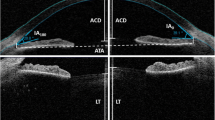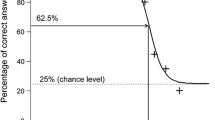Abstract
Background
Clinical measurement of the amplitude of accommodation (AA) provides an indication of maximum accommodative ability. To determine whether there has been a significant change in the AA, it is important to have a good idea of the repeatability of the measurement method used. The aim of the present study was to compare AA measurements made using three different subjective clinical methods: the push-up, push-down, and minus lens techniques. These methods differ in terms of the apparent size of the target, the end point used, or the components of the accommodation response stimulated. Our working hypothesis was that these methods are likely to show different degrees of repeatability such that they should not be used interchangeably.
Methods
The AA of the right eye was measured on two separate occasions in 61 visually normal subjects of mean age 19.7 years (range 18 to 32). The repeatability of the tests and agreement between them was estimated by the Bland and Altman method. We determined the mean difference (MD) and the 95% limits of agreement for the repeatability study (COR) and for the agreement study (COA).
Results
The COR for the push-up, push-down, and minus lens techniques were ±4.76, ±4.00, and ±2.52D, respectively. Higher values of AA were obtained using the push-up procedure compared to the push-down and minus lens methods. The push-down method also yielded a larger mean AA than the negative-lens method. MD between the three methods were high in clinical terms, always over 1.75D, and the COA differed substantially by at least ±4.50D. The highest agreement interval was observed when we compared AA measurements made using minus lenses and the push-up method (±5.65D).
Conclusions
The minus lens method exhibited the best repeatability, least MD (−0.08D) and the smallest COR. Agreement between the three techniques was poor.


Similar content being viewed by others
References
Rosenfield M, Gilmartin B (1990) Effect of target proximity on the open-loop accommodative response. Optom Vis Sci 67:74–79
Hokoda SC (1985) General binocular dysfunctions in an urban optometry clinic. J Am Optom Assoc 56:560–562
Rosenfield M (1997) Accommodation. In: Zadnik K (ed) The ocular examination; measurements and findings. WB Saunders, Philadelphia
Wick B, Hall P (1987) Relation among accommodative facility, lag, and amplitude in elementary school children. Am J Optom Physiol Opt 64:593–598
Goss D (1992) Clinical accommodation testing. Curr Opin Ophthalmol 3:78–82. doi:10.1097/00055735-199202000-00011
Woehrle MB, Peters RJ, Frantz KA (1997) Accommodative amplitude determination: can we substitute the pull-away for the push-up method? J Optom Vis Dev 28:246–249
Brozek J, Simonson E, Bushard WJ, Peterson JH (1948) Effects of practice and the consistency of repeated measurements of accommodation and vergence. Am J Ophthalmol 31:191–198
Rosenfield M, Cohen AS (1996) Repeatability of clinical measurements of the amplitude of accommodation. Ophthalmic Physiol Opt 16:247–249. doi:10.1016/0275-5408(95)00093-3
Chen AH, O’Leary DJ (1998) Validity and repeatability of the modified push-up method for measuring the amplitude of accommodation. Clin Exp Optom 81:63–71
Rouse MW, Borsting E, Deland PN (2002) Reliability of binocular vision measurements used in the classification of convergence insufficiency. Optom Vis Sci 79:254–264. doi:10.1097/00006324-200204000-00012
Scheiman M, Wick B (2002) Clinical management of binocular vision. Heterophoric accommodative and eye movement disorders. Lippincott Williams & Wilkins, Philadelphia
Carlson NB, Kurtz D (2004) Clinical procedures for ocular examination. McGraw Hill, New York
Bland J, Altman DG (1986) Statistical methods for assessing agreement between two methods of clinical measurement. Lancet 1–8476:307–310
Zadnik K, Mutti DO, Adams AJ (1992) The repeatability of measurement of the ocular components. Invest Ophthalmol Vis Sci 33:2325–2333
Argimon JM, Jimenez J (2004) Métodos de investigación clínica y epidemiológica. Harcourt, Madrid
Reeves BC, Hill AR, Aspinall PA (1987) The clinical significance of change. Ophthalmic Physiol Opt 7:441–446
Atchison DA, Capper EJ, McCabe KL (1994) Critical subjective measurement of amplitude of accommodation. Optom Vis Sci 71:699–706. doi:10.1097/00006324-199411000-00005
Ostrin LA, Glasser A (2004) Accommodation measurements in a prepresbyopic and presbyopic population. J Cataract Refract Surg 30:1435–1444. doi:10.1016/j.jcrs.2003.12.045
Rambo VC, Sangal SP (1960) A study of the accommodation of the people of India. With further notes on the development of presbyopia at different ages in different peoples. Am J Ophthalmol 49:993–1004
Kragha IKOK (1989) Measurement of amplitude of accommodation. Ophthalmic Physiol Opt 9:342–343. doi:10.1111/j.1475-1313.1989.tb00925.x
Wold JE, Hu A, Chen S, Glasser A (2003) Subjective and objective measurement of human accommodative amplitude. J Cataract Refract Surg 29:1878–1888. doi:10.1016/S0886-3350(03)00667-9
Fitch RC (1971) Procedural effects on the manifest human amplitude of accommodation. Am J Optom Arch Am Acad Optom 48:918–926
Hokoda SC, Ciuffreda KJ (1982) Measurement of accommodative amplitude in amblyopia. Ophthalmic Physiol Opt 2:205–212
Rosenfield M, Cohen AS (1995) Push-up amplitude of accommodation and target size. Ophthalmic Physiol Opt 15:231–232 letter. doi:10.1016/0275-5408(95)90576-N
Acknowledgements
This study was supported by grant PR1/07-14909 from the Universidad Complutense de Madrid.
Author information
Authors and Affiliations
Corresponding author
Additional information
This study was supported by grant PR1/07-14909 from the Universidad Complutense de Madrid.
Rights and permissions
About this article
Cite this article
Antona, B., Barra, F., Barrio, A. et al. Repeatability intraexaminer and agreement in amplitude of accommodation measurements. Graefes Arch Clin Exp Ophthalmol 247, 121–127 (2009). https://doi.org/10.1007/s00417-008-0938-9
Received:
Revised:
Accepted:
Published:
Issue Date:
DOI: https://doi.org/10.1007/s00417-008-0938-9




